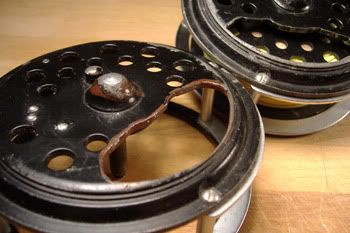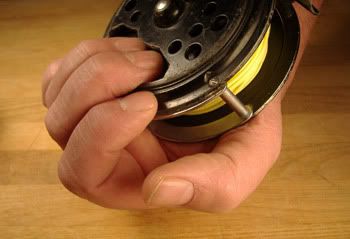I'm actually surprised that I cannot find a good image or video of palming your reel to induce drag, so I guess I'll try and explain so maybe one of the answers in this thread might hit home.
Most reels even if they have a drag system on them are set up so that the clicker or drag prevents "overrunning" the spool. As other have described that is where whether during stripping off line or a fish runs, the line suddenly stops but the spool continues to turn. The result is, since the line is not being taken off the reel it loosens and makes large loose loops within the spool. That can cause problems in various forms, so the drag or clicker is meant to keep that from happening.
The way it does is with a clicker having a spring assisted pawl engage a pawl gear.
As the pawl clicks over the teeth, it slows the spool just enough that it doesn't overrun having nothing to slow it. A disk drag does the same thing yet uses disks that pressure is applied to like the brake on a car.
In the case of a "clicker" type of drag (disk drags often set to the same degree yet can be adjusted higher), the resistance is JUST enough to slow the reel when it turns at a moderate speed, however is light enough that it does not add so much resistance that stripping line from the reel is uncomfortable, or is enough to break a light tippet.
To apply additional resistance to the line going out when say fighting a large fish there are two generally accepted ways to do so. The first less often used being to pinch the line between the reel and the first guide with your thumb and forefinger. Obviously with a large fish or extended runs it will heat up your fingertips, but it is a good way to
let the fish get the line on the reel (stripped off line hanging loose), or to add additional pressure to smaller fish for brief periods.
The second method which will apply from panfish to 1,000# Blue Marlin is to "palm the reel (spool actually)."
To palm the reel, you will press your fingertips, pads of your hand or the heel of your hand to the exposed rim on the handle side of the spool. You're not going to press to the face of the spool where the handle is mounted, yet to its edge about the diameter.
Start by applying minimal pressure and then gradually increase it to where you feel is right. In some cases you'll apply just enough to insure that when the fish stops the spool doesn't overrun, yet with larger fish you might apply even more to add resistance to the fishes pull of the line off the reel.
In all cases however, you must not apply so much pressure as to break the tippet. With light tippets that can be a difficult thing to judge, the rod will aid some in reducing shock when it gives, however if you apply too much and the fish stops then jerks the line again it could cause the tippet to snap.
What you have to remember is if a fish has the power to pull off line and you don't control that line the fish can get loose. In kind if you over control it you can break that line/tippet, or in some cases even bend a hook setting the fish free.
It is however with most reels, even many modern ones how you apply drag to help you fight a fish. I can assure you however, palming a reel instead of using a freight-train drag is rewarding all on its own.
B.E.F.



